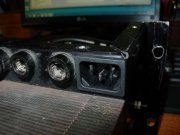According to Joe, there should be only one three prong power cable ground in the system to the homes electrical system ground, this is at the outlet provided the home is wired correctly. This is how my PL2000 preamp is factory wired, a three wire cord with the ground wire connected to the chassis. Now, if I put a three wire cord on the amp and connect the ground wire to the amp chassis, the system will most likely suffer hum from ground loops. This is most likely why the preamps came with three wire ground cords, and the amps did not.
https://forums.phxaudiotape.com/threads/this-grounding-thing.1568/page-2#post-86786 So, when I upgrade my amps to that great power socket and three wire cords, I will not connect the socket ground to the chassis.
Could we see a picture of your three-prong cord PL2000? I have attached a Service Manual for the PL2000/2000 II and page 9 has a schematic of the power supply. I do not see a three wire power cord, but yours could have been a special order. Further, the 117VAC in the PL2000 immediately becomes the primary of a 24VAC center-tapped transformer; that means the rest of the unit is below fatal shock threshold and lightning continuity. I would much rather have the three-prong cord and safety ground connected to the amplifier, where there are fatal shock thresholds throughout the entire chassis.
Now, if you plug your amplifier power plug into the preamp accessory outlet, you will still not be grounding your amplifier because the accessory jacks are two-prong. However, the designer warned us not to exceed the wattage allocated for the accessory jacks and that is typically around 400 Watts maximum per outlet. Any WOPL 700 is going to consume greater than 400 Watts, so the power cord should go to a wall outlet or a dedicated power strip where it can be properly grounded/earthed.
The subject of safety grounding the chassis of a rebuilt PL400/700 (WOPL) has been a debate here for quite a while. Because I run a business and make a profit from my customers, I have contacted a lawyer regarding my liabilities. He stated that as long as I am following 'generally accepted practices' in my construction, I am fairly safe. That includes a three-wire safety cord and a safety ground on the chassis of all the amplifiers I rebuild. You are welcome to do as you wish, of course. I inform all my customers that the amplifier is safety grounded and if there is hum it is due to their house wiring, not the amplifier. I refer them to Section 250.4 of the National Electrical Code (NEC) and Standard 467 of the Underwriters Laboratory (UL).
With regards to signal hum, I do not ground or connect my signal coax input shields to chassis ground or each other. I allow the shields to enter into the WOA Dual Mono Control Board, and the separate shield/common connections flow to the separate WOA Backplane boards and then to the STAR ground that ultimately connects to single point ground on the chassis. For the two chassis ground points, I scrape the paint on the chassis, use sharp star washers, and crimp/solder the insulated terminal connector onto 16 gauge wire. I also add an AC-rated 275V X2 (self-healing in case of arc-over) .1uF safety capacitor (mouser P/N 667-ECQ-UAAF104M) across the line and neutral legs, and two 300V Y2 (never fail short) .01uF safety capacitors (Mouser P/N 72-VY2103M63Y5US63V0) between neutral and ground/line and ground of the power input connections to reduce AC-related noise. This is by design and none of the amps I have built display any 60Hz hum, most often as a result of cable problems or poor shielding; or any 120Hz buzz most often caused by ground loops.

